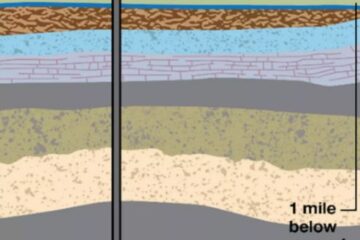Scientists find new and mysterious DDT chemicals accumulating in California condors
Environmental health scientists and toxicologists have identified more than 40 DDT-related compounds accumulating in California condors.
Source of this article: The Los Angeles Times, May 22, 2022
When Christopher Tubbs joined an ambitious multinational effort to save California condors from the brink of extinction, he knew the odds of success were long.
There were wind turbines that could strike the giant birds and lead bullet fragments in hunted animals that could sicken and kill.
But Tubbs, who studies hormone-disrupting chemicals, suspected there was yet another threat to condor survival — a particularly problematic pesticide dumped decades ago off California’s coast.
Now, after years of study, Tubbs and a team of environmental health scientists have identified more than 40 DDT-related compounds — along with a number of unknown chemicals — that have been circulating through the marine ecosystem and accumulating in this iconic bird at the very top of the food chain.

With a 9 1/2-foot wingspan, California condors are the largest land birds in North America. This critically endangered species is at the top of the food chain in the coastal ecosystem.
In a sophisticated chemical analysis published Tuesday in Environmental Science & Technology, the team found that DDT-related chemicals were seven times more abundant in coastal condors than condors that fed farther inland. Looking at the birds’ coastal food sources, researchers found that dolphin and sea lion carcasses that washed ashore in Southern California were also seven times more contaminated with DDT than the marine mammals they analyzed along the Gulf of California in Mexico.
One mysterious chemical that is likely connected to the DDT dumping in California was 56 times more abundant in coastal condors and 148 times more abundant in California dolphins.
“This DDT story, and contaminants interfering with reproduction, is what we call a sublethal exposure,” said Tubbs, a reproductive sciences expert at the San Diego Zoo Wildlife Alliance. “They don’t kill a bird outright, but … they could interfere with estrogen receptors or any other endocrine pathway.”
This latest study builds on much-needed research into DDT’s toxic — and insidious — legacy in California. Public calls for action have intensified since The Times reported that the nation’s largest manufacturer of this pesticide once dumped its waste into the deep ocean. As many as half a million barrels could still be underwater today, according to old records and a UC Santa Barbara study that provided the first real glimpse of this pollution bubbling 3,000 feet under the sea near Catalina Island.
Significant amounts of DDT-related compounds are still accumulating in Southern California dolphins, and a recent study linked the presence of dichlorodiphenyltrichloroethane to an aggressive cancer in sea lions. Another study based in Oakland found that DDT’s hormone-disrupting effects are affecting a new generation of women — passed down from mothers to daughters, and now granddaughters.
Just because we banned DDT 50 years ago doesn’t mean it has gone away — especially in California, said Eunha Hoh, whose lab at San Diego State’s School of Public Health led the chemical analysis in the new condor study. If the California condor is accumulating such high amounts of DDT, that means that every link of the coastal food chain — including people — is also exposed.
“The abundance is so high in Southern California,” said Hoh, who keeps finding this forever chemical reappearing in new and unexpected ways. “We can’t just move on … our ocean is so much more polluted with DDT.”
Condors commanded the skies as early as the Pleistocene, when mammoths, saber-toothed cats and other megafauna prowled California. Many native people such as the Chumash have come to see the giant birds as central to their culture. The Yurok know them as prey-go-neesh.
With its bald, prehistoric-looking head and a wingspan that stretches almost 10 feet, Gymnogyps californianus remains the largest land bird in North America and is a sight to behold in the wild. Its numbers plummeted, however, in the wake of trophy hunting and an increasingly contaminated environment. By 1982, there were only 22 California condors left on the planet.
Federal and state wildlife officials, with the support of conservation advocates, agreed to capture every last bird in hopes of breeding the population back to vitality.
Saving this critically endangered species is particularly tricky: It takes more than six years before a condor is ready to reproduce, and even then, the birds tend to lay only one egg every other year. After decades of painstaking work, there are now 537 California condors, supported by a network of breeding centers and reintroduction sites from Baja California to Northern California.
Given the lead poisoning that often befalls a condor scavenging farther inland, many point to marine mammals as a critical food source for the species’ long-lasting survival in the wild.
But in 2006, when condors released along the Big Sur coast finally started to mate, many of their eggs failed to hatch. Researchers started studying how remnant DDT in the environment could be at play.
“Our ongoing work has demonstrated that the more years a female condor spends on the coast, and thus likely feeding on marine mammals, the lower the probability her egg will hatch,” said Myra Finkelstein, an environmental toxicologist at UC Santa Cruz whose research group has also been instrumental in pinpointing the cause of lead poisoning in condors.
A huge challenge for her field, she said, is the overwhelming number of chemicals polluting the environment. Research like this new study, which Finkelstein reviewed but was not a part of, goes a long way in helping toxicologists figure out where and how to focus their analyses.
For this latest study, researchers at San Diego State’s School of Public Health teamed up with the San Diego Zoo Wildlife Alliance to connect more of the chemical dots.
They took blood samples from 19 condors that soared along the Big Sur coast and 20 condors that lived primarily inland. Using a high-tech instrument known as a mass spectrometer, they sorted through hundreds of chemicals and methodically identified each DDT-related compound in the blood samples — and applied the same technique to the blubber of marine mammals from both the Southern California coast and the Gulf of California.
They cataloged a suite of DDT compounds, including two suspicious chemicals — TCPM and TCPMOH — that are likely a byproduct of DDT manufacturing, explained Nathan Dodder, an environmental analytical chemist at SDSU. These currently unmonitored chemicals were also present in the dolphins they studied, as well as the sediment collected near the barrels dumped in the deep ocean.
Very little is known about these chemicals, said Margaret Stack, an environmental health scientist at SDSU and first author of the paper. She pointed to one study so far that tested TCPMOH on zebrafish — the aquatic-version of lab mice — and found that the chemical is acutely toxic to its embryos at elevated concentrations.
These are all clues that could help determine what to look for when tracing the legacy of DDT through the coastal ecosystem, said Lihini Aluwihare, a marine chemist at the Scripps Institution of Oceanography who was not affiliated with the study.
“We really need to understand where these animals are accessing the DDT. … What [this study] adds is a more comprehensive look at the fingerprint of pollutants in the condors,” said Aluwihare, who has been piecing together how various sources of DDT have been entering the food web. “This gives us something to compare, once we get the kind of data that we’re looking for from the dumpsites.”
David Valentine, whose UC Santa Barbara research team first came across the submerged barrels, said that the discovery of TCPM in such high concentrations is a big piece of the puzzle.
He’s convening key scientists, regulators and policymakers in a conference this week to discuss next steps. Researchers recently received a round of funding from Congress to do more chemical analysis and gather more data — including more mapping of the seafloor to determine the scope of the dumping.
Many agree that there is an overall need for better monitoring — not just for the DDT-related chemicals that we know about, but also the ones that might be emerging after so many decades of interacting with the environment.
“We now see it in marine mammals, particularly dolphins. We’ve known about some of the fish in shallow water. We know that sea lions have higher burdens of DDT-related compounds, and now we’re seeing the condors are also accumulating both DDT and these other DDT-related compounds in the form of TCPM,” Valentine said. “To me, that says that we’ve got a problem. … We need to now go back and understand what the legacy of those compounds really was — and understand where it’s coming from, and what we might be able to do moving forward.”
Back on the southernmost reaches of the condor’s historic habitat, Ignacio Vilchis has been guiding the recovery team down in Baja California — coordinating across borders to help these endangered birds thrive again in the wild.
With the latest findings showing that the Gulf of California is much less contaminated for condors, he hopes that releasing more birds in Baja could help the overall population sustain itself well into the future.
An oceanographer by training, Vilchis sees the condor as inseparable from the health and future of our ocean. If we are able to save the condor, he said, that means we are also saving so much other life along the way.
His face lights up as he describes the awe he feels when a condor soars overhead. Their wings are so immense that you can hear them beating the air.
“It’s just … it’s very majestic,” he said, at a momentary loss for words. “There’s something very magical about them. You look up and there’s a 10-foot wingspan flying above. It always gives me chills.”



0 Comments